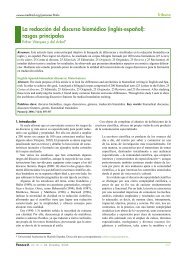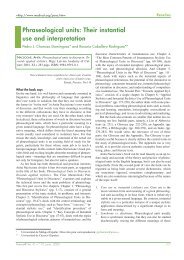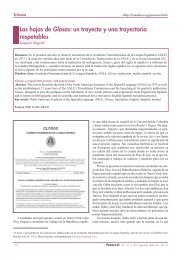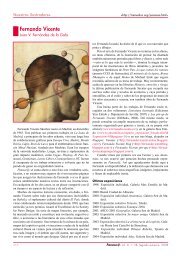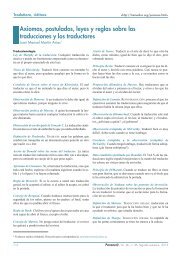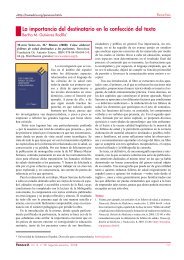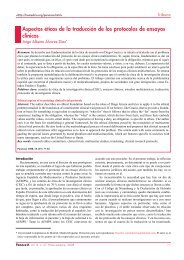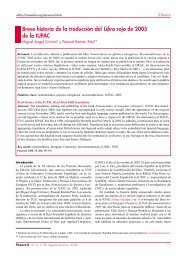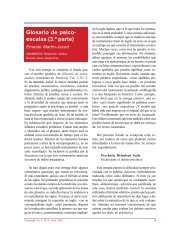Vol. 1, n.º 2. Diciembre del 2000
Vol. 1, n.º 2. Diciembre del 2000
Vol. 1, n.º 2. Diciembre del 2000
You also want an ePaper? Increase the reach of your titles
YUMPU automatically turns print PDFs into web optimized ePapers that Google loves.
orígenes de la drogodependencia y no tiene en<br />
cuenta la locución inglesa “most commonly” que<br />
introduce esta sentencia. De este modo, desvirtúa<br />
todo el significado <strong>del</strong> original.<br />
AIDS. Abreviatura de Acquired Immunodeficiency<br />
Syndrome… Síndrome <strong>del</strong> sistema inmunitario caracterizado<br />
por la aparición de enfermedades oportunistas,<br />
incluyendo la candidiasis, (orofaringea y vulvovaginal),<br />
pneumonía por neumocistis carinii, leucoplaquia<br />
oral, herpes zoster, púrpura idiopática, trombocitopénica,<br />
displasia cervical y carcinoma cervical, sarcoma<br />
de Kaposi, enfermedad pélvica inflamatoria, toxoplasmosis,<br />
isoporiasis, criptococosis, linfoma no-Hodgkin<br />
y neumopatía periférica. La tuberculosis puede considerarse<br />
también una infección oportunística. El síndrome<br />
es causado por el virus de la inmunodeficiencia<br />
humana (VIH-1, VIH-2) que se transmite a través <strong>del</strong><br />
intercambio de fluidos corporales… La principal característica<br />
de la inmunodeficiencia es la depleción de<br />
los linfocitos T4 cooperadores/inductores, como primer<br />
resultado <strong>del</strong> tropismo selectivo <strong>del</strong> virus por los<br />
linfocitos. La linfoadenopatía persistente generalizada,<br />
la fiebre, pérdida de peso, la diarrea de larga duración<br />
(más de un mes) se asocian a las primeras etapas<br />
de la enfermedad. SYN síndrome de inmunodeficiencia<br />
adquirida. Ya en 1994, los centros para el control de<br />
la enfermedad calcularon en un millón el número de<br />
personas portadoras <strong>del</strong> VIH en EE.UU y en 339.250<br />
el de infectadas por el SIDA. Se estimaba que en todo<br />
el mundo había unos 10 millones de personas infectadas<br />
con una supuesta mayor incidencia en algunos<br />
países <strong>del</strong> África central y oriental donde al menos un<br />
tercio de la población puede considerarse como VIHpositiva.<br />
(Pág. 29 <strong>del</strong> diccionario Ruiz-Torres)<br />
AIDS. A syndrome of the immune system<br />
characterized by opportunistic diseases, including<br />
candidiasis (both oropharyngeal and vulvovaginal),<br />
pneumocystis carinii pneumonia, oral hairy<br />
leukoplakia, herpes zoster, idiopathic thrombocytopenic<br />
purpura, cervical dysplasia and cervical carcinoma,<br />
Kaposi’s sarcoma, pelvic inflammatory<br />
disease, toxoplasmosis, isosporiasis, cryptococcosis,<br />
non-Hodgkin’s lymphoma, and peripheral<br />
neuropathy. Tuberculosis may also be considered<br />
to be an opportunistic infection. The syndrome is<br />
caused by the human immunodeficiency virus (HIV-<br />
1, HIV-2), which is transmitted by exchange of body<br />
fluids... Hallmark of the immunodeficiency is<br />
depletion of T4 + helper/inducer lymphocytes,<br />
primarily the result of selective tropism of the virus<br />
for the lymphocytes. Persistent generalized<br />
lymphadenopathy, fever, weight loss, and diarrhea<br />
of long duration (lasting more than 1 month) are<br />
associated with early stages of the disease. SYN<br />
acquired immunodeficiency syndrome.<br />
As of 1994, the Centers for Disease Control put<br />
the number of HIV-infected people in the U.S. at 1<br />
million, and those with full-blown AIDS at 339,250.<br />
Some 10 million people are estimated to be infected<br />
worldwide, with the highest suspected incidence in<br />
some Central and East African countries, where as<br />
much as a third of the adult population may be HIVpositive...Voz<br />
original inglesa (pág. 39 de la 26ª ed.<br />
<strong>del</strong> diccionario Stedman)<br />
Orofaringea quiere decir orofaríngea. En lugar<br />
de pneumonía por neumocistis carinii debería<br />
decir neumonía por Pneumocystis carinii y<br />
en vez de isoporiasis, isosporiasis. No hay infecciones<br />
oportunísticas sino oportunistas, ni neumopatías<br />
periféricas sino neuropatías periféricas.<br />
Hablar de displasia y carcinoma cervical sin precisar<br />
que se trata <strong>del</strong> cuello uterino no es muy<br />
exacto. “Como primer resultado” es una mala traducción<br />
de primarily the result (principalmente<br />
por el tropismo o como consecuencia <strong>del</strong> tropismo…).<br />
Los centros para el control de la enfermedad<br />
son un organismo estadounidense oficial y,<br />
en este caso, o bien se alude a su ubicación (Atlanta,<br />
EE.UU.) o resulta preferible dejar la denominación<br />
original Centers for Disease Control.<br />
Antibody. Anticuerpo. Molécula de inmunoglobulina<br />
con una secuencia de aminoácidos específica<br />
producida en el hombre o en los animales por un<br />
antígeno y que se caracteriza por… (Pág. 68 <strong>del</strong> diccionario<br />
Ruiz-Torres)<br />
antibody (Ab). An immunoglobulin molecule with<br />
a specific amino acid sequence evoked in man or other<br />
animals by an antigen, and characterized by... Voz<br />
original inglesa (pág. 99 de la 26ª ed. <strong>del</strong> diccionario<br />
Stedman)<br />
Esta voz, pésimamente traducida de la en-<br />
Panace@ <strong>Vol</strong>. 1, No. <strong>2.</strong> <strong>Diciembre</strong>, <strong>2000</strong> 61



